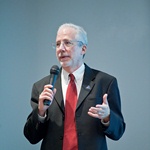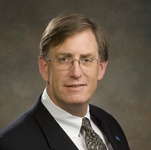Purdue's School of Aeronautics and Astronautics Graduates Play Key Role in NASA's Orion Program
| Event Date: | January 26, 2015 |
|---|
On December 5, 2014, people around the world watched with excitement and fascination as NASA successfully launched the Orion spacecraft. The test flight mission, lasting almost four and a half hours, took a spacecraft further into space than any manned vehicle since the Apollo missions over forty years ago.
The crowd gathered to view the Orion launch in the early morning hours at Kurz Atrium in Neil Armstrong Hall of Engineering was reminded yet again of the School of Aeronautics and Astronautics’ enormous contributions to space exploration.
Purdue’s reputation as the Cradle of Astronauts is firmly established through the efforts of the men and women who have made significant contributions to the space program. Our graduates are inextricably connected to these space endeavors through the outstanding achievements of its past and present faculty members, and the countless aerospace engineers who have received their training from these committed professors.
NASA’s Associate Administrator for Human Exploration and Operations, William H. Gerstenmaier (BSAAE’77; OAE’03; DEA’07), right, is the associate administrator for the Human Exploration and Operations Directorate at NASA Headquarters in Washington, DC. In this position, Gerstenmaier provides strategic direction for all aspects of NASA's human exploration of space and cross-agency space support functions of space communications and space launch vehicles. He provides programmatic direction for the continued operation and utilization of the International Space Station, development of the Space Launch System and Orion spacecraft, and is providing strategic guidance and direction for the commercial crew and cargo programs that will provide logistics and crew transportation for the International Space Station.
For more information about William Gerstenmaier, visit: http://www.nasa.gov/about/highlights/gerstenmaier_bio.html#.VMAe82PhKSo
NASA Orion Program Manager Mark Geyer (BSAAE’82; MSAAE’83), left, is responsible for taking the Orion mission from the conceptual phase into a program which accomplishes the objectives set forth by NASA. This includes responsibility for the day-to-day management, development, and integration of Orion system crewed exploration system. He has held this position since 2007.
 Geyer began his career at Lockheed Space Systems in California working on orbit mechanics design for Department of Defense satellite systems. He joined NASA in 1990 working in advanced programs, and led the International Space Station (ISS) team that integrated the Russian elements into the program, working with the Russian Space Agency and their contractors. He then moved into the lead role for integration of all the international partners and was responsible for designing the sequence of ISS assembly and the primary office for technical integration of the International Partners International Space Station elements.
Geyer began his career at Lockheed Space Systems in California working on orbit mechanics design for Department of Defense satellite systems. He joined NASA in 1990 working in advanced programs, and led the International Space Station (ISS) team that integrated the Russian elements into the program, working with the Russian Space Agency and their contractors. He then moved into the lead role for integration of all the international partners and was responsible for designing the sequence of ISS assembly and the primary office for technical integration of the International Partners International Space Station elements.
Additionally, Geyer served as Manager of the System Engineering and Integration for the Development Program Division of the Exploration Systems Mission Directorate at NASA Headquarters in Washington, D.C.; and Deputy Program Manager of the Constellation Program.
Read more about Mark Geyer at: https://engineering.purdue.edu/AAE/AboutUs/News/Events/20140327_Colloquium_Mark_Geyer
 NASA Orion Program Chief Engineer Julie Kramer White (BSAAE’90), right, represents the NASA engineering community on the Mission Management Team (MMT), which is comprised of a small group of the most senior spacecraft leadership. Kramer White has a broad array of NASA experience, including expertise in Structures and Materials, Loads and Dynamics, Propulsion, Mechanical Systems, Aerosciences, and Thermal Protection.
NASA Orion Program Chief Engineer Julie Kramer White (BSAAE’90), right, represents the NASA engineering community on the Mission Management Team (MMT), which is comprised of a small group of the most senior spacecraft leadership. Kramer White has a broad array of NASA experience, including expertise in Structures and Materials, Loads and Dynamics, Propulsion, Mechanical Systems, Aerosciences, and Thermal Protection.
While a student in the School of AAE, Kramer White was part of a NASA cooperative education program where she began learning about various aspects of human space flight. This program shaped her future, and led to more than 25 years of working on the Space Shuttle program. Her assignments at NASA include supporting all of the human spaceflight programs, including Space Shuttle Orbiter, the International Space Station, the X-38 vehicle, and the Orion Program.
For more on Julie Kramer White, including a video interview, visit: http://women.nasa.gov/julie-kramer-white/
 School of AAE Professor of Practice Dan Dumbacher (BSME’81), left, most recently served as deputy associate administrator in the Exploration Systems Development Division, for the Human Exploration and Operations Mission Directorate at NASA Headquarters. In this position, Dumbacher provided leadership and management to the exploration systems development programs which include the Space Launch System (SLS), the Orion program, and the Ground Systems Development and Operations (GSDO) development and integration.
School of AAE Professor of Practice Dan Dumbacher (BSME’81), left, most recently served as deputy associate administrator in the Exploration Systems Development Division, for the Human Exploration and Operations Mission Directorate at NASA Headquarters. In this position, Dumbacher provided leadership and management to the exploration systems development programs which include the Space Launch System (SLS), the Orion program, and the Ground Systems Development and Operations (GSDO) development and integration.
His previous NASA assignments included Director of the Engineering Directorate at NASA’s Marshall Space Flight Center; Deputy Director of the Ares Projects Office; Deputy Director for Product Assurance in the Safety and Mission Assurance Office; manager of the X-37 Flight Demonstrator; Deputy Manager of the Space Launch Initiative Program; and Program Flight Manager of the Second Generation Reusable Launch Vehicle Program. Dumbacher joined the faculty of the School of Aeronautics and Astronautics in August 2014. His research areas include Aerospace Systems and Systems of Systems.
To read Professor Dumbacher’s complete biography, visit: https://engineering.purdue.edu/Engr/People/NewFaculty/New_Faculty_2014/Dumbacher.html
In addition to these high-ranking personnel, Purdue University has more than 60 graduates who are directly involved in the Orion Program through their work at NASA, Lockheed Martin, and Honeywell. These alums hold positions in thermal control systems, avionics, guidance, software, propulsion, mechanical systems, crew module, ground handling, and others. The contributions of these Purdue grads are numerous, and we salute them for their achievements in the Orion Program.
The Purdue Chapter of the American Institute of Aeronautics and Astronautics (AIAA) sponsored a competition for School of AAE undergraduate students to attend the Orion EFT-1 launch in Cape Canaveral, Florida with Professor Dumbacher. The undergraduate student attendees included: Seniors Emily Zimovan and Stephen Whitnah; Juniors Katherine Fowee and Paul Witsburger; and Sophomores Karl Jantze and Emily Shulz. To read more about the students, visit: https://engineering.purdue.edu/AAE/Spotlights/20141106Spotlightsixstudentsselectedtoviewlaunch
For more information on the Orion Program, visit: http://www.nasa.gov/exploration/systems/mpcv/index.html#.VL_IYmPhKSo
For details of the successful Orion test flight launch on December 5, 2014, visit: http://www.nasa.gov/content/successful-launch-of-orion-heralds-first-step-on-journey-to-mars/#.VL_yTWPhKSo
To learn more about the Purdue School of Aeronautics and Astronautics role in the history of the manned space program, visit: https://engineering.purdue.edu/AAE/AboutUs/Alumni/Distinguished/Astronautbios/PurdueAstronauts.html
